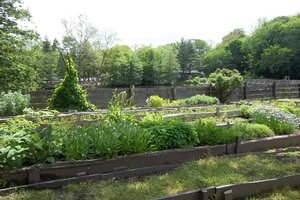A visit to a slave garden
Near Tarrytown, N.Y., Philipsburg Manor re-creates a slave garden that shows how slaves in the 1700s grew food for themselves and to sell.

How the slave garden looked in mid-May. Roses and chamomile have already been picked to make rosewater and tea. Rose petals and chamomile flowers are also dried for future use. Cool-weather vegetables and herbs, such as chives, which were started early in raised beds, are ready to harvest.
Courtesy of Lois J. de Vries
Our recent journey along the Hudson River included a visit to Philipsburg Manor House and Garden, a living history farm located near Tarrytown, N.Y.
The original manor, which encompassed 54,000 acres, dates from a 1693 land grant and was established by the Anglo-Dutch merchant Frederick Philipse.
He ran his enterprise as a plantation that furnished supplies for the Atlantic sea trade and as headquarters for a worldwide shipping operation.
The manor house, garden, and a commercial mill were built along the Pocantico River, so that small boats could ferry grain and dairy products to sailing ships that were anchored in the nearby Hudson River.
Entering a woodland time machine
Because the usual entry point (over the bridge across the mill pond dam) was closed for repairs, we reached the farm via a path that runs beside the the pond.
To my way of thinking, this was actually the better route to take. The farm was hidden from view by the leaves of surrounding trees during our leisurely stroll, which was just long enough to lose touch with the sights and sounds of the town of Sleepy Hollow.
We entered the path during the 21st century and emerged at the other end ... 300 hundred years earlier.
Heritage breeds of goats and sheep ran past us and clambered freely over logs and rocks. Cows chewed their cud contentedly in the barnyard, while costumed docents went about their historic chores. The peaceful silence was broken only by the rush of water over the dam.
Plants grown in the slave garden
In the 18th century, it was common practice in rural areas to allocate garden plots to enslaved men and women so that they could supplement their limited food ration.
While this meant extra work for the slaves, they did benefit by being able to grow foods that they preferred such as white and sweet potatoes, beans, black-eyed peas, cayenne pepper, winter squash, and various greens.
Many of the plants are easy to grow, are high-yield, and could be resown every few weeks, allowing the garden to be more productive over a longer period of time.
Potatoes could be stored in pits; peas and beans could be eaten fresh or dried. Greens could be planted in late summer and continue to produce into late fall or early winter. All of these plants could be cooked easily, by boiling in a pot of water or by being roasted in coals.
Even though it was a violation of existing law, the Philipsburg slaves were also allowed to sell surplus produce from their plots to earn cash at the weekly market in West Chester.
Raised beds made gardening easier
At Philipsburg, wide plank fencing surrounds the slave garden, which has been planted to reflect general practices of the day, with raised beds separated by paths of oyster shells.
The raised beds enable the soil in them to warm up earlier in spring, giving seeds planted there a head start over seeds planted directly in the ground. The beds provide improved drainage, and easy tilling, fertilizing, and cultivating.
Philipsburg Manor is included in Westchester County’s African American Heritage Trail. A PDF brochure and map that describes all 13 stops on the trail can be downloaded here.
For a more detailed account of American slave gardens, visit the Colonial Williamsburg website.
If you go:
Tickets for Philipsburg Manor House tours are available through Historic Hudson Valley, which operates a museum gift shop and cafe at the site.
-----
Lois de Vries, a popular speaker at regional flower shows and garden clubs, writes from her home in rural northwestern New Jersey. To read her other posts at Diggin' It, click here. She's a field editor for Better Homes and Gardens and Country Gardens magazines and has been a contributing editor for other national publications. She was awarded the Jefferson Presidential Award for public service in environmental work. Click here and here to read about her garden design and environmental ideas and her holistic approach to gardening.You can also follow her on Twitter and Facebook.
